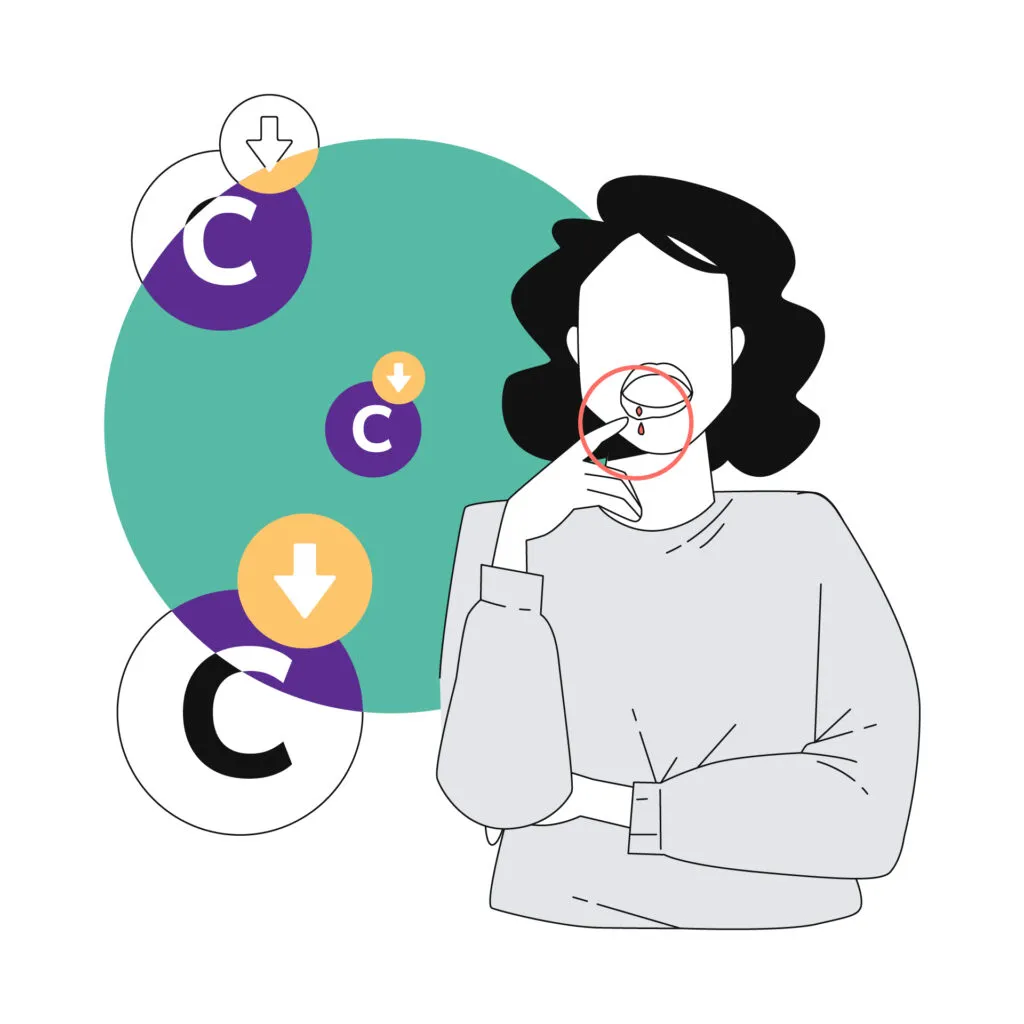Oral Health | 5 min read
Scurvy Disease: 4 Important Things to Know About It
Medically reviewed by
Table of Content
Synopsis
Though the scurvy disease is rare, it is wise to know how vitamin C deficiency can lead to severe scurvy symptoms in certain conditions. Get to know about the A to Z of scurvy causes, symptoms and treatment here.
Key Takeaways
- Scurvy disease is caused by a deficiency of vitamin C
- A scurvy outbreak usually takes place in low-income, famine-struck countries
- Common scurvy symptoms include anemia, blurred vision, and more
Scurvy is a disease caused by vitamin C deficiency. Note that vitamin C, an essential dietary nutrient also known as ascorbic acid, plays a key role in the growth and functions of different physiological structures and systems, such as:
- Absorption of iron
- Formation of neurotransmitters, like epinephrine and dopamine
- Healing of wounds
- Function of antioxidants
- Collagen production
Apart from these, vitamin C may also aid the metabolism of protein and cholesterol.
Scurvy disease can lead to conditions such as exhaustion, bleeding, anaemia, inflammation, and pain in the limbs. In some instances, scurvy can also cause ulcers in the gums and loss of teeth. Read on to learn more about scurvy disease and how you can come out of vitamin C deficiency.
History and facts about scurvy
The existence of scurvy can be traced back to the ancient Egyptian civilisation [1]. Some people link it with the sailors in the 16th-18th century [2]. It is said that those sailors suffered from scurvy disease during their extended sea voyages, where it was impossible to get fresh foods regularly [3]. Many also lost their lives due to vitamin C deficiency. Scurvy disease again broke out during the Irish potato famine in 1845 [4] and the American Civil War in 1861-65. The latest scurvy disease outbreak occurred in 2002 in Afghanistan, struck by war and drought.
Presently, scurvy has become a rare disease [5] worldwide as fresh vegetables and fruits are available in abundance. However, it is always a threat in financially marginalised and exploited countries [6].
Additional Read: Top 20 Superfoods to Build Immunity and Healthy DietCommon vitamin C deficiency symptoms
With the help of vitamin C, our body absorbs iron and produces collagen. Vitamin C's other roles include synthesising energy-producing compounds such as carnitine, epinephrine, norepinephrine, and dopamine. Vitamin C deficiency causes a gap in the production of collagen, leading to the gradual degeneration of tissues. Usually, early signs of vitamin C deficiency appear within 8-12 weeks. They include the following:
- No appetite
- Tiredness
- Rapid weight loss
- Ache in legs
- Irritability
- Sudden exhaustion
However, gradually conditions may worsen, and you may experience several additional scurvy symptoms and conditions within 1-3 months:
Vitamin C deficiency diseases list
- Oedema
- Anaemia
- Corkscrew hairs
- Trouble breathing
- Light sensitivity
- Dry eyes accompanied by irritation and swelling
- Depression and mood swings
- Pain in muscles and bones
- Blurred vision
- Infection in gum and loss of teeth
- Chest pain
- Headache
- Small red spots under the skin due to internal bleeding
- Gastrointestinal haemorrhage
- Tender and inflamed joints
- Jaundice
- Convulsions
- Fever
- Neuropathy
If left untreated, scurvy can thus become a life-threatening condition.
The cause of scurvy disease and major risk factors
A deficiency of vitamin C causes scurvy disease. However, there are certain risk factors from which the deficiency may stem. Here's a look at them:
- Eating disorder (anorexia) and related mental health conditions
- An unhealthy diet with limited access to fresh fruits and vegetables, usually in low-income or famine-struck countries
- Late weaning of infants
- Old age
- Disabilities
- Limited income forces people to compromise on diets
- Living as a refugee
- Suffering from severe diarrhoea
- Dehydration
- Restriction in diets on account of allergies
- Irritable bowel syndrome
- Substance addiction or alcohol consumption beyond the limit
Certain other conditions and therapies can be risk factors for vitamin C deficiency. They include chemotherapy, dialysis, Crohn's disease, smoking, ulcerative colitis, and more.
Additional Read: Best Vitamins and Supplements to Boost Immune System
Scurvy treatment procedures
Despite the severe syndromes, treating vitamin C deficiency or scurvy disease is quite easy. You can take vitamin C from multiple natural sources, including popular fruits and vegetables. The nutrient is also part of several snack foods, cereals, and juices. If you are experiencing the initial symptoms of scurvy, you can consult a doctor to understand how many vitamins per day you would need for treatment. Usually, five servings of vitamin C-filled meals a day are enough to come out of scurvy symptoms. Your doctor may also suggest vitamin C supplements such as multivitamins. You can take them via mouth or injections. For mild scurvy, symptoms usually disappear within a few days. However, in cases of severe scurvy, doctors may prescribe high doses of vitamin C for an extended period. Take a look at the following table to understand the recommended doses for the treatment of scurvy disease.
Recommended doses | Adult | Children |
First phase | 1,000 mg per day for at least a week | 300 mg per day for at least a week |
Second phase | 300-500 mg per day for one week | 100 mg daily until symptoms improve |
In the case of scurvy, you can expect an improvement in 24-72 hours and complete recovery within three months. In usual cases, there are no long-term effects unless you suffer from a chronic dental infection.
Conclusion
With a clear idea of scurvy definition and the importance of vitamin C-rich foods, you can simply add different sources of vitamin C to your diet to make it healthier yet delicious. You can also consult a doctor to understand which vitamin C foods will be best for you. Remember, you can always book an online or offline consultation on Bajaj Finserv Health as per your flexibility. Follow a balanced diet and have your check-ups on time to live life to the fullest!
FAQs
How to diagnose scurvy disease?
Usually, doctors identify scurvy disease based on the vitamin C deficiency syndromes visible in a person. Unfortunately, for adults, there are no other reliable remedies to check for scurvy. However, in cases of childhood scurvy, an x-ray report can help to identify any internal damage.
How to prevent scurvy disease?
Here are the vitamin C doses for individuals of different ages to prevent deficiency, recommended by medical authorities:
- For infants aged up to 6 months: 40 mg
- For infants aged between 7-12 months: 50 mg
- For children aged between 1-3 years: 15 mg
- For children aged between 4-8 years: 25 mg
- For young adults aged between 9-13 years: 45 mg
- For teenagers aged between 14-18 years: 65 mg for females, 75 mg for males
- For adults aged 19 years and beyond: 75 mg for females, 90 mg for males
What are the common food sources of vitamin C?
Fruits: papaya, kiwi, guava, blackberry, strawberry, lemon, orange, and moreVegetables: spinach, cabbage, potatoes, broccoli, bell peppers, carrots, tomatoes, and moreReferences
- https://pubmed.ncbi.nlm.nih.gov/29539504/
- https://dash.harvard.edu/bitstream/handle/1/8852139/Mayberry.html
- https://europepmc.org/article/pmc/pmc8437177
- https://www.parliament.uk/about/living-heritage/evolutionofparliament/legislativescrutiny/parliamentandireland/overview/the-great-famine/
- https://www.ncbi.nlm.nih.gov/pmc/articles/PMC7400810/#:~:text=This%20study%20assessed%20%3E22%2C400%20participants,and%200.8%25%20for%20women).
- https://www.ncbi.nlm.nih.gov/pmc/articles/PMC6249652/
Disclaimer
Please note that this article is solely meant for informational purposes and Bajaj Finserv Health Limited (“BFHL”) does not shoulder any responsibility of the views/advice/information expressed/given by the writer/reviewer/originator. This article should not be considered as a substitute for any medical advice, diagnosis or treatment. Always consult with your trusted physician/qualified healthcare professional to evaluate your medical condition. The above article has been reviewed by a qualified doctor and BFHL is not responsible for any damages for any information or services provided by any third party.





